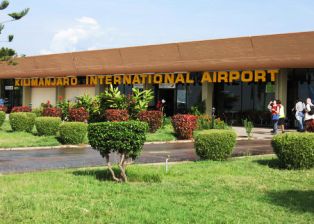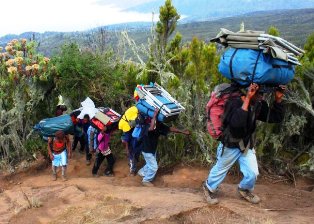How to Climb Kilimanjaro Cheap
Here are the steps to get the cheapest price on a Kilimanjaro climb:
 1.
Do not pre-book a climb
1.
Do not pre-book a climb
2. Climb during the low season
3. Find a guide/operator in country
4. Select a shorter route
5. Bring your own equipment
6. Reduce the number of crew members
Don't pre-book a climb
To get a low price Kilimanjaro climb, you have to be willing to take risks, the biggest of which is that you will not arrange your climb prior to arriving in Tanzania. In other words, you will not know who your tour operator will be. You will not know who the guide is until hours before you depart.
The goal is to find a budget operator who has availability to take you up the mountain on short notice and is willing to forgo their typical profit margin to do so.
 Climb
in the low season
Climb
in the low season
Between March to June and during November, tourism in Tanzania is low due to the rainy seasons. If you are willing to climb during the rainy season, you can expect cheaper prices for everything - flights, hotels, transportation and the climb.
You can save money, but consider how you would tolerate being consistently wet during your trip and if it is worth the tradeoff. Additionally, it is far more dangerous and uncomfortable to be on Kilimanjaro during the rainy season, and the success rate is lower due to these factors.
Flights into Kilimanjaro International Airport from North America are not cheap. They range from $1,500 to as high as $5,000! Prices fluctuate throughout the year and sometimes it is a just of matter of luck and good timing that you can find a flight at a reasonable price. It is usually cheaper to fly into Dar Es Salaam, Tanzania or Nairobi, Kenya, and take a local bus to Arusha or Moshi.
The local shuttle buses cost about $30. You can take an overnight bus to save on hotel accommodations. The bus ride is 8-10 hours long from Dar Es Salaam or Nairobi to Moshi or Arusha.
 Finding
a guide in country
Finding
a guide in country
Once you are in Moshi or Arusha, begin visiting Kilimanjaro operators to inquire about availability and prices. Do not bother talking to the touts - the sales people who approach you on the streets. They are hustlers who will rip you off or scam you outright.
Go directly to an office to deal with company managers or owners - people who have the authority to negotiate price. When discussing the climb, make sure you understand what is included and excluded in the quoted price, especially park fees.
Note that it is highly unlikely you will be able to book Kilimanjaro climb with an immediate departure for a discount with the top operators. They have limited availability and are firm on pricing. So focus on the local budget companies. Most budget companies are not running high quality treks given that they are attracting customers mostly by offering a low price rather than providing great service. So don't expect too much from these operators.
If possible, try to meet the actual guide. Most of the guide's abilities and character won't be apparent until you are able to spend time with him on the mountain. However, talk as much as you can before the trip to assess him. Ask about his experience. Ask him about the mountain. Ask him about safety precautions. Does he speak English fluently? Do you like his personality? Do you feel comfortable trusting him with your life?
Select a shorter climbing route
 Discuss
the different climbing options with the tour company. The cheapest
climbs are going to be the Kilimanjaro
routes that are shorter, require fewer porters, and have trailheads
that are closer to town.
Discuss
the different climbing options with the tour company. The cheapest
climbs are going to be the Kilimanjaro
routes that are shorter, require fewer porters, and have trailheads
that are closer to town.
The cheapest route is the 5 day "Coca Cola route", also known as Marangu. Marangu is the shortest route, uses hut accommodations (which eliminates the need to carry tents), and is located near Moshi. Marangu is the most popular route.
The second cheapest route is the 6 day "Whiskey route", also known as Machame. Of all the camping routes, Machame has a nearby trailhead. Machame is the second most popular route.
Note that the number of days on the mountain has a strong effect on altitude acclimatization. Picking a shorter route decreases the chances of summiting. Five and six day routes are for experienced climbers who acclimatize quickly. If unknown, it is better to add extra days on the mountain to prevent sickness.
Bring your own equipment and supplies
The equipment of Kilimanjaro operators get steady use every climbing season and as a result, wear and tear on equipment can lead to costly and frequent repair and replacement. Therefore, to reduce costs, you can try to limit the usage of the operator's equipment by offering to use your own.
Come equipped with all the gear and equipment needed on the trek
- tents, sleeping bags and pads, clothing, utensils ,
camp stove and even food. Ask the company what equipment they include
in their climb prices, then tell them you do not need any of it. It
is a negotiation point for you to lower the price.
,
camp stove and even food. Ask the company what equipment they include
in their climb prices, then tell them you do not need any of it. It
is a negotiation point for you to lower the price.
Limit the number of crew members
Try to reduce the number of crew members that accompany you on the climb. If possible, hire only the guide. Most operators will only sell supported climbs with large crews. But if you can hire just a guide, and ditch the assistant guide, cook and porters, your costs will drop tremendously.
Every crew member you exclude means it should cost a little bit less.
But to even think about climbing without a complete crew, you must
be in very good shape. Be prepared to carry 60 lb. packs at high altitude
if need be.
<<<Kilimanjaro Climb Price and Cost
||||||||||||||||||||||||||||||||||||||||||||||||||||||||||||||||||||||||
Pre-booking a
Kilimanjaro Climb>>>
